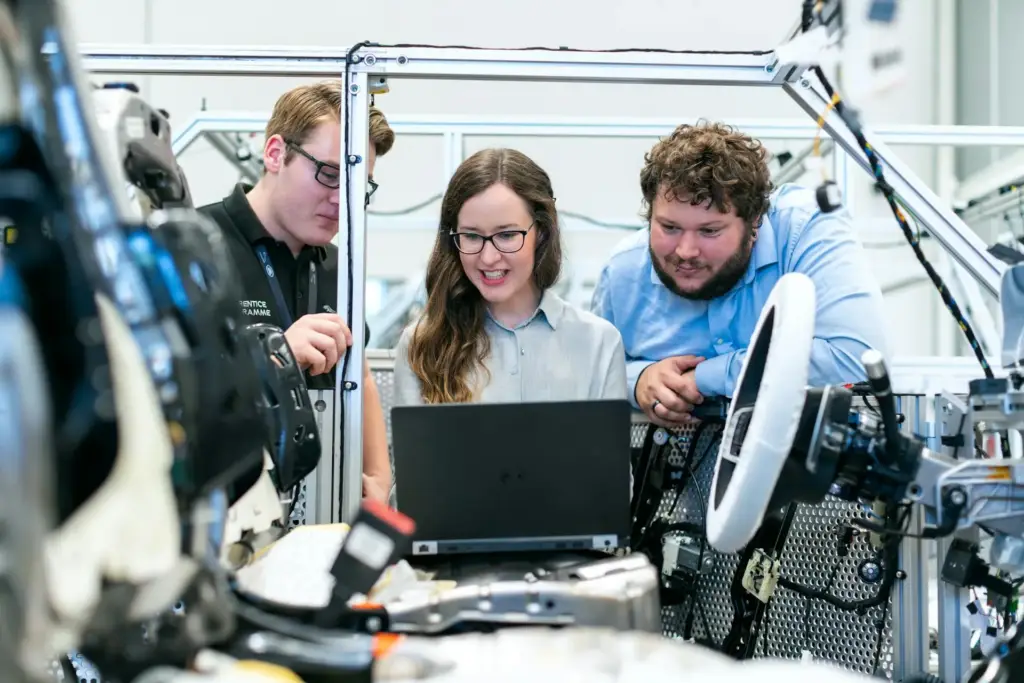Human-Machine Collaboration has become one of the most relevant topics in the current context of technological innovation. As artificial intelligence (AI) advances, the relationship between humans and machines is changing. Rather than replacing workers, AI is enabling people and machines to collaborate to improve efficiency, increase productivity and enhance creativity. In this article, we explore how Human-Machine Collaboration is revolutionizing different industries and how it can be effectively implemented.

What is Human-Machine Collaboration?
Human-Machine Collaboration refers to the joint work between people and artificial intelligences to achieve common goals. Rather than seeing AI as a substitute for human skills, it is understood as a tool to amplify those skills, bringing efficiency to repetitive tasks and analysis of large amounts of data. This allows humans to focus on activities that require creativity, critical judgment and empathy.
This collaboration can be seen in a variety of industries such as medicine, manufacturing, commerce and entertainment. Advances in machine learning, natural language processing and robotics have enabled machines to assist humans in complex tasks ranging from decision making to real-time problem solving.
Benefits of Human-Machine Collaboration
One of the greatest benefits of Human-Machine Collaboration is the ability to combine the strengths of both sides. Machines excel at quickly analyzing large volumes of data and performing repetitive tasks with high accuracy. Humans, on the other hand, bring qualities such as creative thinking, empathy and complex problem solving that require judgment and adaptability.
In healthcare, for example, AI systems can quickly analyze medical images and patient data to suggest diagnoses, while physicians use their clinical expertise and judgment to make final decisions. This combined approach not only improves accuracy, but also reduces diagnostic time, which can save lives.
In manufacturing, Human-Machine Collaboration allows robots to perform repetitive assembly tasks, while humans monitor and make creative adjustments or solve complex problems. This combination improves efficiency on production lines and reduces errors.
Challenges of Human-Machine Collaboration
Despite the benefits, Human-Machine Collaboration also presents challenges.One of the main ones is the need to ensure that human-machine interaction is smooth and effective.For collaboration to work, AIs must be designed in a way that is easy for humans to use and interpret. This implies intuitive interfaces and transparent algorithms that allow users to understand how and why the AI makes certain decisions.
Another challenge is trust. Humans can be reluctant to trust machines, especially in critical situations such as healthcare or financial decision-making. To overcome this obstacle, it is essential that AIs demonstrate their reliability through consistent and understandable results, which will build confidence in their use.
Strategies for Effective Collaboration
To achieve effective Human-Machine Collaboration, it is important to implement strategies that facilitate working together. Here are some of the keys:
- Training and Education: Workers must be trained to work with AI systems and understand how to leverage their capabilities. Lack of knowledge about AI technologies can lead to resistance, while proper education can foster more productive collaboration.
- Human-Centered Design: AI tools must be designed with end users in mind. This means intuitive interfaces and systems that facilitate decision making, rather than complicate workflow.
- Continuous Feedback: Humans must be able to provide feedback to AI systems to improve their performance over time. This feedback process ensures that AI adapts and evolves according to human needs.
- Transparency and Explainability: AI systems must be transparent, allowing users to understand the machine’s decisions and recommendations. This helps build trust and facilitates collaboration in critical situations.
Human-Machine Collaboration Success Stories
A clear example of Human-Machine Collaboration is the automotive industry. Automobile factories use AI-controlled robots to perform precise assembly tasks, while human workers oversee the process and deal with more complicated problems. Combining the two skills has led to increased production, improved quality and reduced costs.
In customer service, companies are using chatbots and virtual assistants to handle simple, repetitive queries. When requests become more complex, humans step in to provide personalized solutions, creating a more efficient and satisfying user experience.
Conclusion
Human-Machine Collaboration is leading the way to a future in which humans and artificial intelligences will work together efficiently and harmoniously. The key to success in this collaboration is to design systems that enhance human abilities rather than replace them. By overcoming challenges and implementing appropriate strategies, Human-Machine Collaboration can transform entire industries and improve the way we work and live.

